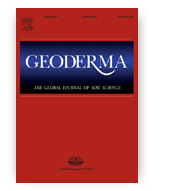Glossic planosols in the postglacial landscape of central europe: Modern polygenetic soils or subaerial palaeosols?
Cezary Kabała, Elżbieta Musztyfaga, Zdzisław Jary, Jarosław Waroszewski, Bernard Gałka, Mirosław Kobierski
Geoderma
Ministerial score = 200.0
Journal Impact Factor (2022) = 7.422 (Q1)
 Texturally bipartite and stagno-gleyed Planosols are becoming more commonly reported from the temperate climate zone. Although ferrolysis is widely accepted as the major process responsible for abrupt textural change in South American Planosols, clay illuviation or native lithogenic discontinuity is understood to be more important for texturally distinct profile differentiation in other regions of the world. Textural discontinuities, accompanied by seasonal water stagnation, are common in the (post)glacial landscapes of Central and Northern Europe, and extend the possibility for Planosol recognition, which has previously been considered atypical of this region. However, a unique combination of lithogenic, periglacial and pedological features has raised questions about the classification and genesis of these soils. In particular, an Eemian age for the illuvial clay (argic) horizon in loamy subsoils developed from pre-Vistulian ice-sheets has been hypothesised. Eight texturally bipartite soil profiles (sandy over loamy), located within the range of the older Saalian ice-sheet (Polish: Odra) were inves- tigated from the Lower Silesia region (SW Poland). Abrupt changes in the relative contributions of particle size fractions, heavy minerals, rare-earth elements, rounded and semi-rounded sand grains, and clay minerals, as well as the presence of wind-polished periglacial pavements, accompanied by Late Pleistocene–Holocene optically stimulated luminescence ages for the cover sands, have confirmed the different lithogeneses of the topsoil and subsoil layers as the reason for the abrupt textural difference in the soil profiles. Macro- and micromorphological observations support the following model of Glossic Planosol development in SW Poland: (a) formation of illuvial soil (Luvisol type), including its argic horizon, during the Eemian; (b) truncation of profile (erosion of eluvial horizons) during the cold stages of the Last Glacial Maximum, followed by the formation of a periglacial pavement, soil cracking and the cryogenic reworking of the illuvial structures in the argic horizon (Marine Isotope Stage [MIS] 4–MIS 2); and (c) soil burial with wind-transported sands (during MIS 2, remodelling in the Holocene), which formed a lithological discontinuity at the top of argic horizon. During the Holocene period, the upper argic horizon has been transformed by extending the albeluvic tonguing under a humid temperate climate. Observations from SW Poland support the hypothesis that Luvic/Glossic Planosols in the older (post)glacial landscapes are polygenetic soils, in terms of both their litho- and pedogeneses, the formation of which started in the Eemian and is still active
Texturally bipartite and stagno-gleyed Planosols are becoming more commonly reported from the temperate climate zone. Although ferrolysis is widely accepted as the major process responsible for abrupt textural change in South American Planosols, clay illuviation or native lithogenic discontinuity is understood to be more important for texturally distinct profile differentiation in other regions of the world. Textural discontinuities, accompanied by seasonal water stagnation, are common in the (post)glacial landscapes of Central and Northern Europe, and extend the possibility for Planosol recognition, which has previously been considered atypical of this region. However, a unique combination of lithogenic, periglacial and pedological features has raised questions about the classification and genesis of these soils. In particular, an Eemian age for the illuvial clay (argic) horizon in loamy subsoils developed from pre-Vistulian ice-sheets has been hypothesised. Eight texturally bipartite soil profiles (sandy over loamy), located within the range of the older Saalian ice-sheet (Polish: Odra) were inves- tigated from the Lower Silesia region (SW Poland). Abrupt changes in the relative contributions of particle size fractions, heavy minerals, rare-earth elements, rounded and semi-rounded sand grains, and clay minerals, as well as the presence of wind-polished periglacial pavements, accompanied by Late Pleistocene–Holocene optically stimulated luminescence ages for the cover sands, have confirmed the different lithogeneses of the topsoil and subsoil layers as the reason for the abrupt textural difference in the soil profiles. Macro- and micromorphological observations support the following model of Glossic Planosol development in SW Poland: (a) formation of illuvial soil (Luvisol type), including its argic horizon, during the Eemian; (b) truncation of profile (erosion of eluvial horizons) during the cold stages of the Last Glacial Maximum, followed by the formation of a periglacial pavement, soil cracking and the cryogenic reworking of the illuvial structures in the argic horizon (Marine Isotope Stage [MIS] 4–MIS 2); and (c) soil burial with wind-transported sands (during MIS 2, remodelling in the Holocene), which formed a lithological discontinuity at the top of argic horizon. During the Holocene period, the upper argic horizon has been transformed by extending the albeluvic tonguing under a humid temperate climate. Observations from SW Poland support the hypothesis that Luvic/Glossic Planosols in the older (post)glacial landscapes are polygenetic soils, in terms of both their litho- and pedogeneses, the formation of which started in the Eemian and is still active
DOI:10.1016/j.geoderma.2022.116101









